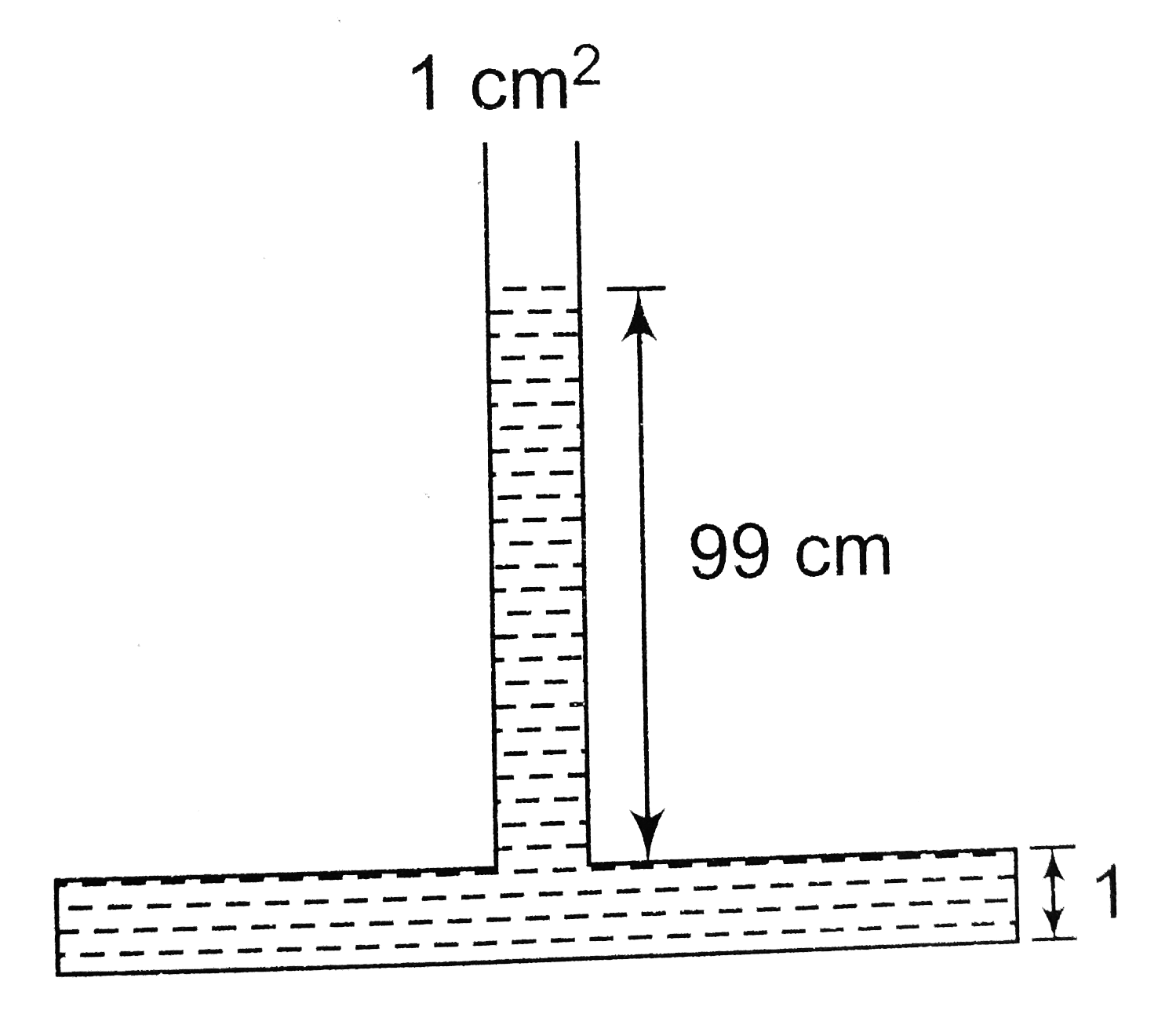The area of base of a cylindrical vessel is 300cm2.
Water (density= 1000kg/m3) is poured into it up to a depth of 6 cm. Calculate the pressure . (g=10m s−2).
To calculate the pressure exerted by the water in the cylindrical vessel, we can follow these steps:
Step 1: Convert the depth of water to meters
The depth of water is given as 6 cm. We need to convert this to meters for consistency with the other units.
Depth=6cm=6×10−2m=0.06m
Step 2: Use the formula for pressure
The pressure exerted by a fluid at a certain depth can be calculated using the formula:
P=h×ρ×g
Where:
- P is the pressure,
- h is the depth of the fluid,
- ρ is the density of the fluid,
- g is the acceleration due to gravity.
Step 3: Substitute the known values into the formula
From the problem, we have:
- h=0.06m
- ρ=1000kg/m3
- g=10m/s2
Now substituting these values into the pressure formula:
P=0.06m×1000kg/m3×10m/s2
Step 4: Calculate the pressure
Now we can perform the multiplication:
P=0.06×1000×10=600Pa
Final Answer
The pressure exerted by the water in the cylindrical vessel is:
Pressure=600Pa
---
The depth of water is given as 6 cm. We need to convert this to meters for consistency with the other units.
The pressure exerted by a fluid at a certain depth can be calculated using the formula:
- P is the pressure,
- h is the depth of the fluid,
- ρ is the density of the fluid,
- g is the acceleration due to gravity.
From the problem, we have:
- h=0.06m
- ρ=1000kg/m3
- g=10m/s2
Now we can perform the multiplication:
The pressure exerted by the water in the cylindrical vessel is:
Topper's Solved these Questions
- BOOK - ICSECHAPTER - FLUIDSEXERCISE - TOPIC 1 (3 Marks Questions )18videos
FLUIDS
- BOOK - ICSECHAPTER - FLUIDSEXERCISE - TOPIC 1 (4 Marks Questions )10videos
FLUIDS
- BOOK - ICSECHAPTER - ELECTRICITY AND MAGNETISM EXERCISE - TOPIC 2 Magnetism (4 Marks Questions )6videos
ELECTRICITY AND MAGNETISM
- BOOK - ICSECHAPTER - HEAT AND ENERGYEXERCISE - EXERCISE -6(D) Multiple Choice Question)4videos
HEAT AND ENERGY
Similar Questions
The area of base of a cylindrical vessel is 300cm2.
Water (density= 1000kg/m3) is poured into it up to a depth of 6 cm. Calculate the thrust of water on the base. (g=10m s−2).View SolutionThe area of base of a cylindrical vessel is 300cm2. Water (density=1000kgm−3) is poured into it up to a depth of 6 cm. Calculate : (a) the pressure and (b) the thrust of water on the base. (g=10ms−2).
View SolutionThe density of cooking oil is 1.2g/cm3. What is its density in kg/m3 ?
View SolutionThe circumference of the base of a cylindrical vessel is 132 cm and its height is 25 cm.How many litres of water can it hold? (1000cm3=1l)
View Solution1gcm−3=1000kgm−3
View SolutionA tube 1cm2 in cross- section is attached to the top of a vessel 1 cm high and of cross - section 100 cm2 Water is poured into the system filling it to a depth of 100 cm above the bottom of the vessel as shown in fig. Take g =10 ms−2 .
 View Solution
View SolutionA tube 1cm2 in cross- section is attached to the top of a vessel 1 cm high and of cross - section 100 cm2 Water is poured into the system filling it to a depth of 100 cm above the bottom of the vessel as shown in fig. Take g =10 ms−2 .
 View Solution
View SolutionThere is some water in a cylindrical vessel of radus 6 cm a sphere of radus 2 cm is dropped in to the vessel .Find the increase in the height of water surface.
View SolutionThere is an air bubble of radius 1.0 mm in a liquid of surface tension 0.075Nm−1 and density 1000kgm−3. The bubble is at a depth of 10 cm below the free surface. By what amount is the pressure inside the bubble greater than the atmospheric pressure? Take g=9.8ms−2.
View SolutionAn iceberg of density 900kg/m3 is floating in water of density 1000kg/m3. The percentage of volume of ice cube outside the water is
View Solution

